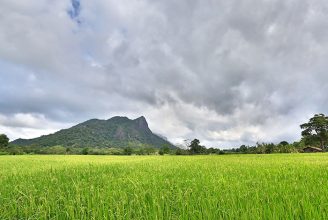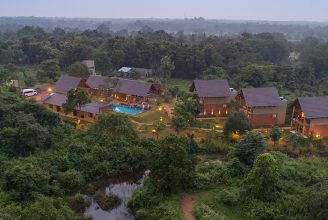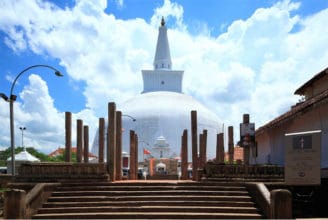Wilpattu National Park
Land of Lakes
Wilpattu National Park (‘Land of Lakes’) is situated on the Northwest coast near the ancient city of Anuradhapura. It is the largest and oldest National Park in Sri Lanka, consisting of 140,000 hectares of mostly dry zone evergreen forest cover and a coastal belt to the West. This is one of best places to see leopards in Sri Lanka alongside Yala National Park. The open grassy plains are set within the thick dense scrub jungle. The wetland includes around 48 shallow natural lakes known as Villus, natural basins that are filled up with rainwater and two salt water lakes. These natural lakes are the most important parts of the complex eco-system in the park.
The park is home to elusive leopards, elephants, sloth bears, water buffalos, Mugger Ccocodiles, Spotted and Barking deer, wild boar and pythons. Alongside these wild animals you may be able to see many endemic birds include the Ceylon Junglefowl, Brown-capped Babbler, Ceylon Woodshrike and Black-capped Bulbul in riverine habitats. Butterflies recorded include the Great Eggfly, Great Orange Tip, Glad-eye Bushbrown, Blue Mormon, Common Mormon, Common Rose and Crimson Rose. Diverse varieties of colourful butterflies can be seen in the park as well. You may see the wild animals, particularly elephants, near lakes in the early morning and late afternoons. The wildlife is abundant around the lakes and coastal belt, here you may spot the White Ibis, Open Bills, Painted Storks Spoonbills, Egrets, Whistling Teals, Kingfishers and you may also see the water buffalos, monitors and crocodiles.
Wilpattu National Park, located in the northwest of Sri Lanka, is a significant and rewarding destination for wildlife enthusiasts. It holds the distinction of being the largest and one of the oldest national parks in the country.
Here is a summary of its key features, wildlife, and safari experience.
Unique Features
- Villu (Natural Lakes): The defining characteristic of Wilpattu is its network of nearly a hundred “villu”—natural, shallow, sand-rimmed lakes that fill with rainwater. The name “Wilpattu” itself translates roughly to “Land of the Lakes.” These water bodies are crucial for sustaining the park’s diverse flora and fauna, especially during the dry season, making them prime spots for wildlife viewing.
- Size and Serenity: Covering an area of approximately , Wilpattu is vast. Compared to more famous parks like Yala, it sees less tourism footfall, offering a quieter, more serene, and less crowded safari experience.
- Ecosystem: The park is located in the lowland dry zone and features a variety of habitats, including dense scrub forest, open grasslands, and thick jungle.
Wildlife Highlights
Wilpattu is a premier destination for spotting some of Sri Lanka’s most iconic and elusive animals.
| Category | Key Species to Spot |
| Mammals | Sri Lankan Leopard (Panthera pardus kotiya), Sri Lankan Sloth Bear (Melursus ursinus inornatus), Asian Elephant (Elephas maximus maximus), Spotted Deer, Sambar Deer, Barking Deer, Mouse-deer, Water Buffalo, Mongoose, and Purple-faced Langur. |
| Reptiles | Mugger Crocodile, Indian Python, Common Cobra, Monitor Lizard, and Sri Lankan Flapshell Turtle. |
| Birds | Over 200 species recorded, including endemics like the Sri Lankan Junglefowl and Ceylon Grey Hornbill, as well as the Malabar Pied Hornbill, Crested Serpent Eagle, and Indian Peafowl. |
Leopard Density: The park is world-renowned for its leopard population. Recent studies have estimated the population density to be around 18 leopards per in the effectively sampled core area. While leopard sightings may be less frequent than in Yala National Park, the dense vegetation means a successful sighting is often enjoyed without the presence of many other jeeps.
Safari and Best Time to Visit
- Safari Experience: Safaris are conducted in a 4×4 jeep, with options for half-day (morning or afternoon) or full-day excursions. Early morning (starting at 6:00 AM) and late afternoon are considered the best times for spotting animals, especially predators like leopards and sloth bears.
- Best Time to Visit: The park is open year-round, but the best time for wildlife viewing is generally during the dry season, from May to September (and extending to early October). As water sources dry up, wildlife tends to congregate around the remaining villus, making them easier to spot. The months from February to October are generally recommended.
- Location & Access: Wilpattu is located on the northwest coast of Sri Lanka. It is approximately a 4-hour drive from Colombo and about 40 minutes from the ancient city of Anuradhapura.
Local Hotels

Unsure Where To Start?
Let’s talk about your Earth Trip


Our travel specialists are seasoned explorers with deep local insights. Whether it’s uncovering hidden gems or planning immersive cultural experiences, we design trips that go beyond the ordinary. Get in touch today!
Request A Video Meeting













 Wilpattu National Park
Wilpattu National Park